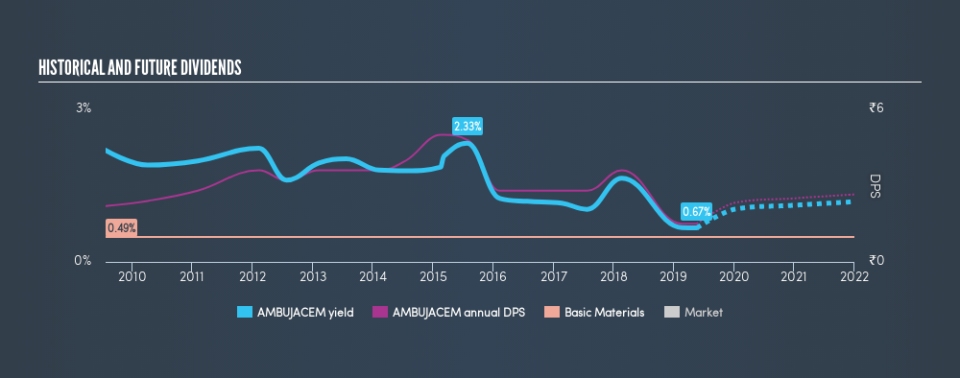Should You Buy Ambuja Cements Limited (NSE:AMBUJACEM) For Its Dividend?

Today we'll take a closer look at Ambuja Cements Limited (NSE:AMBUJACEM) from a dividend investor's perspective. Owning a strong business and reinvesting the dividends is widely seen as an attractive way of growing your wealth. Yet sometimes, investors buy a stock for its dividend and lose money because the share price falls by more than they earned in dividend payments.
A slim 0.7% yield is hard to get excited about, but the long payment history is respectable. At the right price, or with strong growth opportunities, Ambuja Cements could have potential. Some simple analysis can offer a lot of insights when buying a company for its dividend, and we'll go through this below.
Explore this interactive chart for our latest analysis on Ambuja Cements!
Want to participate in a short research study? Help shape the future of investing tools and you could win a $250 gift card!
Payout ratios
Dividends are typically paid from company earnings. If a company pays more in dividends than it earned, then the dividend might become unsustainable - hardly an ideal situation. Comparing dividend payments to a company's net profit after tax is a simple way of reality-checking whether a dividend is sustainable. Ambuja Cements paid out 13% of its profit as dividends, over the trailing twelve month period. We like this low payout ratio, because it implies the dividend is well covered and leaves ample opportunity for reinvestment.
Another important check we do is to see if the free cash flow generated is sufficient to pay the dividend. The company paid out 87% of its free cash flow as dividends last year, which is adequate, but reduces the wriggle room in the event of a downturn.
While the above analysis focuses on dividends relative to a company's earnings, we do note Ambuja Cements's strong net cash position, which will let it pay larger dividends for a time, should it choose.
Remember, you can always get a snapshot of Ambuja Cements's latest financial position, by checking our visualisation of its financial health.
Dividend Volatility
Before buying a stock for its income, we want to see if the dividends have been stable in the past, and if the company has a track record of maintaining its dividend. Ambuja Cements has been paying dividends for a long time, but for the purpose of this analysis, we only examine the past 10 years of payments. Its dividend payments have fallen by 20% or more on at least one occasion over the past ten years. During the past ten-year period, the first annual payment was ₹2.20 in 2009, compared to ₹1.50 last year. This works out to be a decline of approximately -3.8% per year over that time. Ambuja Cements's dividend hasn't shrunk linearly at -3.8% per annum, but the CAGR is a useful estimate of the historical rate of change.
Dividend Growth Potential
With a relatively unstable dividend, it's even more important to see if earnings per share (EPS) are growing. Why take the risk of a dividend getting cut, unless there's a good chance of bigger dividends in future? Ambuja Cements has grown its earnings per share at 6.8% per annum over the past five years. With a decent amount of growth and a low payout ratio, we think this bodes well for Ambuja Cements's prospects of growing its dividend payments in the future.
Conclusion
Dividend investors should always want to know if a) a company's dividends are affordable, b) if there is a track record of consistent payments, and c) if the dividend is capable of growing. Ambuja Cements's dividend payout ratios are within normal bounds, although we note its cash flow is not as strong as the income statement would suggest. Unfortunately, earnings growth has also been mediocre, and the company has cut its dividend at least once in the past. Ultimately, Ambuja Cements comes up short on our dividend analysis. It's not that we think it is a bad company - just that there are likely more appealing dividend prospects out there on this analysis.
Companies that are growing earnings tend to be the best dividend stocks over the long term. See what the 13 analysts we track are forecasting for Ambuja Cements for free with public analyst estimates for the company.
We have also put together a list of global stocks with a market capitalisation above $1bn and yielding more 3%.
We aim to bring you long-term focused research analysis driven by fundamental data. Note that our analysis may not factor in the latest price-sensitive company announcements or qualitative material.
If you spot an error that warrants correction, please contact the editor at editorial-team@simplywallst.com. This article by Simply Wall St is general in nature. It does not constitute a recommendation to buy or sell any stock, and does not take account of your objectives, or your financial situation. Simply Wall St has no position in the stocks mentioned. Thank you for reading.

